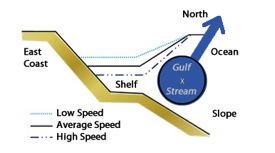Processes Affecting Sea-Level Trends
Sea level varies almost continuously due to tides, storm surge, weather systems, and other processes that act on time scales of hours to days to weeks. Our report-card analysis removes these short-term variations to focus on longer term trends in sea level caused by climate-related changes in the mass, volume, and regional distribution of seawater; changes in shoreline elevation; or both. Complex interactions among these long-term processes can lead to significant differences in sea-level trends in different regions, or in some cases at localities relatively near each other. Alternatively, these interactions can result in similar sea-level trends in areas that lie far apart.
Below we explain the long-term processes that affect sea level and sea-level trends at the global, regional, and local scale. To discover how these processes affect sea-level trends at a particular tidal station, visit our Localities page. To discover their influence on a regional scale, visit our East Coast, Gulf Coast, West Coast, and Alaska pages. For full technical details, read our report.
Processes Explained
Steric ProcessesSteric processes describe changes in the density and volume of seawater due to changes in its temperature (thermosteric) or salinity (halosteric). Warming and freshening reduces the density of seawater, thus increasing its volume and contributing to sea-level rise. Cooler and saltier water is more dense, occupies less volume, and thus contributes to sea-level fall. Steric processes are important to global predictions of climate-mediated sea-level change such as those issued by the IPCC. |
Eustatic ProcessesEustatic processes describe changes in the mass of water in the oceans. Melting of ice sheets and glaciers; increased runoff from lakes, rivers, and groundwater; and increased oceanic precipitation all lead to eustatic sea-level rise. These processes are important to global predictions of climate-mediated sea-level rise such as those issued by the IPCC. |
Glacial Isostatic Adjustment
|
Atmospheric ProcessesThe “inverted barometer” effect is the response of ocean height to atmospheric pressure. Sea level rises beneath a low-pressure system, most noticeably during hurricanes and other intense storms. Conversely, sea level falls beneath a high-pressure cell, as seen during periods of clear, calm weather. Consistent winds can produce a similar effect, pushing water levels higher downwind and causing water levels to fall upwind. Although pressure and wind effects act in the short term, they may affect the trends seen in long-term tide-gauge analyses and thus need to be considered in our analysis. |
Ocean Dynamics
|
Groundwater/Oil PumpingWithdrawal of groundwater or hydrocarbons such as oil and gas can lead to a relative rise in sea level due to local subsidence of the land surface. These localized processes are likely to affect only one or two tide stations and therefore contribute greatly to regional variation. Understanding their magnitude and impact is critical for adaptation and management efforts, since pumping can be controlled relatively easily. Past subsidence can also greatly impact sea-level trends and thus must be carefully considered when choosing the appropriate length of record to analyze. |
Process Scale and Effect
These processes affect different components of sea-level change, and act on different geographic scales.
| Rise/Fall | Acceleration | Variability | |
| Steric | Global | ||
| Eustatic (Greenland/Antarctic Melting) | Global | ||
| Glacial Isostatic Adjustment | Regional | ||
| Atmospheric Processes | Unknown | Regional | |
| Ocean Dynamics | Global-Regional | ||
| Groundwater/Oil Pumping | Local |
Processes By Locality
For a closer look at how sea-level processes vary geographically, visit our East Coast, Gulf Coast, and West Coast pages. For full technical details, read our report.

 GIA is the response of the Earth’s surface to the unloading of ice-sheet and glacial mass. This results in upward motion (rebound) of the land surface in areas previously covered by ice, and subsidence (fore-bulge collapse) in land areas previously displaced upward by the adjacent ice-sheet “dimple.” Subsidence of a coastal area equates to a rise in sea level relative to the land, and vice versa.
GIA is the response of the Earth’s surface to the unloading of ice-sheet and glacial mass. This results in upward motion (rebound) of the land surface in areas previously covered by ice, and subsidence (fore-bulge collapse) in land areas previously displaced upward by the adjacent ice-sheet “dimple.” Subsidence of a coastal area equates to a rise in sea level relative to the land, and vice versa. Shifts in ocean currents and water masses can affect sea-level height; for instance, a weakening of the Gulf Stream (as predicted by climate-change models) can
Shifts in ocean currents and water masses can affect sea-level height; for instance, a weakening of the Gulf Stream (as predicted by climate-change models) can